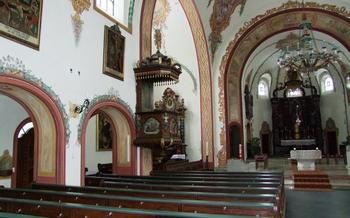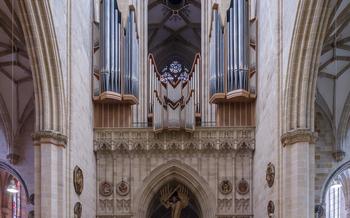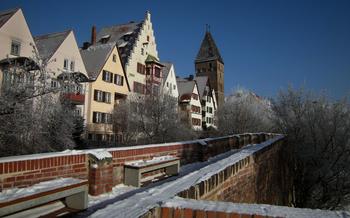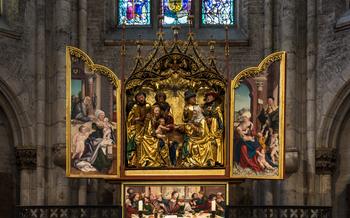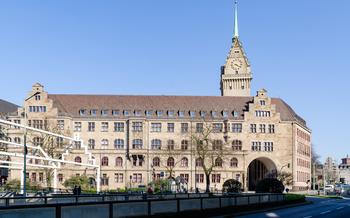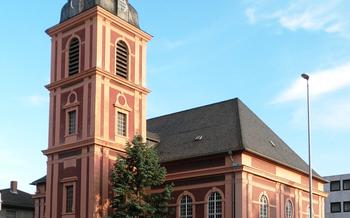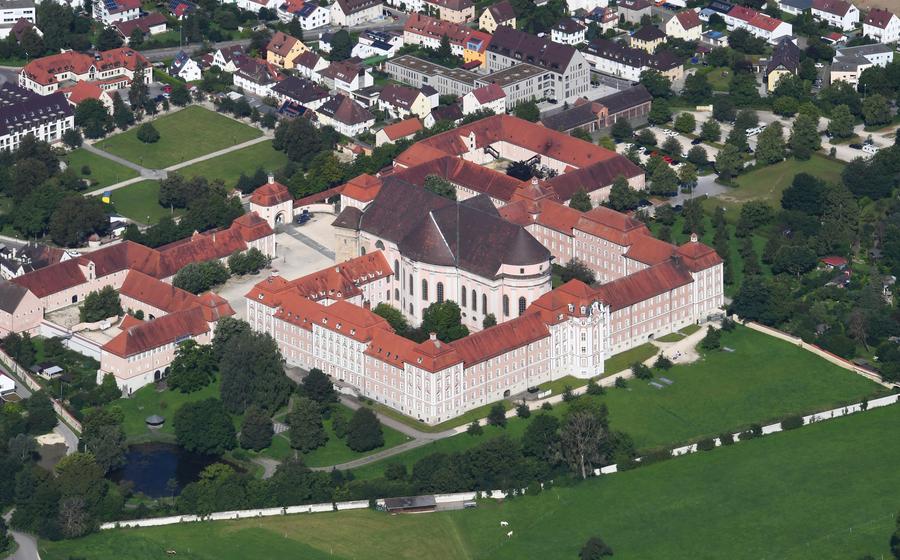
Wiblingen Abbey
- Wiblingen Abbey: A Baroque Masterpiece in Ulm
- The Abbey Church: A Symphony of Baroque Art
- The Monastery Buildings: Echoes of Benedictine Life
- The Ceiling Frescoes: A Masterpiece by Johann Michael Rottmayr
- The High Altar: A Showcase of Baroque Splendor
- The Organ: A Majestic Instrument of Worship
- The Library: A Treasure Trove of Knowledge
- The Refectory: Where Monks Gathered for Meals
- The Gardens: A Haven of Peace and Serenity
- The Abbey Shop: A Source of Unique Souvenirs
- Plan Your Visit: Essential Information
- Best Time to Visit: Capture the Abbey's Charm
- Photography Tips: Capturing the Abbey's Beauty
- Insider Tip: Discover Hidden Gems
Wiblingen Abbey: A Baroque Masterpiece in Ulm
Wiblingen Abbey stands as a testament to the grandeur of Baroque architecture, a masterpiece nestled in the heart of Ulm, Germany. Founded in 1093 by the Benedictine order, the abbey has a rich and storied history, serving as a center of religious devotion, learning, and community for centuries. Today, it invites visitors to step into a world of artistic wonders, architectural marvels, and spiritual heritage.
As you approach the abbey, its imposing Baroque façade greets you, hinting at the treasures that lie within. The church, the centerpiece of the complex, boasts an awe-inspiring interior adorned with intricate frescoes, elaborate stucco work, and a magnificent high altar that showcases the finest craftsmanship of the era.
The monastery buildings, once home to the Benedictine monks, offer a glimpse into their daily lives. Explore the former living quarters, the refectory where they gathered for meals, the library where they pursued their studies, and other functional spaces that reveal the rhythms and rituals of their monastic existence.
Wiblingen Abbey is a testament to the enduring power of faith, art, and community. Its Baroque splendor continues to inspire and captivate visitors, making it a must-see destination for anyone seeking a journey into the heart of German history and culture.
The Abbey Church: A Symphony of Baroque Art
The abbey church of Wiblingen Abbey is a masterpiece of Baroque architecture, boasting an awe-inspiring interior adorned with intricate frescoes and stucco work. As you step inside, your eyes are immediately drawn to the stunning ceiling, which is adorned with breathtaking frescoes by the renowned artist Johann Michael Rottmayr. These frescoes depict biblical scenes and allegorical representations with remarkable detail and artistry, creating a sense of grandeur and spirituality.
The high altar, a focal point of the church, is a masterpiece of Baroque craftsmanship. Its elaborate carvings and sculptures depict scenes from the life of Jesus Christ and the Virgin Mary, showcasing the exceptional skill and artistry of the Baroque era. The intricate details and symbolism of the altar invite you to contemplate the stories and teachings of Christianity.
The church also houses an impressive organ, a magnificent instrument that fills the space with its rich and powerful sound. Built by renowned organ builder Johann Andreas Silbermann, the organ features intricate carvings and delicate pipes, reflecting the Baroque passion for craftsmanship. Attend a concert or recital to experience the organ's full glory and be transported by the enchanting melodies that reverberate through the abbey's hallowed halls.
The Monastery Buildings: Echoes of Benedictine Life
Step through the threshold of the monastery buildings and immerse yourself in the echoes of Benedictine life. Explore the former living quarters of the monks, where simplicity, order, and devotion once reigned supreme. Each room tells a story, whispering secrets of a life dedicated to prayer, work, and community.
Discover the refectory, where the monks gathered for their communal meals. Imagine the clatter of dishes, the murmur of conversations, and the occasional laughter echoing through the hall. The simple yet functional design reflects the Benedictine emphasis on moderation and humility.
Venture into the library, a treasure trove of knowledge and wisdom. Rows upon rows of books line the shelves, inviting you to delve into the depths of theology, philosophy, and history. The monks spent countless hours here, studying and contemplating, seeking enlightenment and spiritual growth.
Explore the chapter house, where the abbot and monks met to discuss matters of governance and community life. The atmosphere here was one of contemplation, discernment, and mutual support, as they sought to live out their monastic vows faithfully.
The Ceiling Frescoes: A Masterpiece by Johann Michael Rottmayr
The ceiling frescoes of Wiblingen Abbey are a true masterpiece, a symphony of colors and forms that transports visitors to a realm of celestial beauty. Created by the renowned Austrian artist Johann Michael Rottmayr, these breathtaking paintings adorn the vaults of the abbey church, covering an area of over 2,000 square meters.
Rottmayr's frescoes depict a series of biblical scenes, each one a testament to his artistic genius and deep understanding of religious iconography. The central fresco, "The Glorification of the Virgin Mary," is a tour de force, showcasing the artist's ability to capture movement, emotion, and divine light. Mary, surrounded by a host of angels and saints, ascends towards the heavens, her figure radiating with grace and majesty.
The surrounding frescoes depict scenes from the Old and New Testaments, including the Creation, the Fall of Man, and the life of Christ. Rottmayr's brushstrokes are confident and expressive, bringing to life the drama and emotion of each narrative. The vivid colors and dynamic compositions create a sense of movement and energy that draws the viewer into the stories.
Beyond their aesthetic beauty, the ceiling frescoes are also rich in symbolism and iconography. Rottmayr carefully selected each element to convey theological messages and reinforce the abbey's spiritual mission. The frescoes serve as a visual catechism, guiding the faithful through the mysteries of the Christian faith.
To fully appreciate the grandeur of Rottmayr's masterpiece, take your time to study the details of each fresco. Notice the intricate facial expressions, the flowing draperies, and the symbolic motifs that enhance the narrative. The ceiling frescoes are not just works of art; they are sacred texts, inviting viewers to contemplate the divine and experience the transformative power of beauty.
The High Altar: A Showcase of Baroque Splendor
The high altar of Wiblingen Abbey is a masterpiece of Baroque craftsmanship, captivating visitors with its intricate carvings and sculptures. The central figure of the Virgin Mary, radiant in her heavenly glory, commands attention with her graceful posture and serene expression. Surrounding her are a host of angels, saints, and cherubs, each meticulously carved with exquisite detail.
The stories depicted in the reliefs surrounding the altar add depth and symbolism to the artwork. Scenes from the life of Mary and Jesus unfold, inviting viewers to contemplate the sacred narratives that have shaped Christian faith for centuries. The vibrant colors and expressive gestures of the figures create a sense of dynamism and emotion, bringing the biblical stories to life.
One of the most striking features of the high altar is its elaborate tabernacle, adorned with intricate carvings and surmounted by a radiant monstrance. This central element of the altar serves as a reminder of the abbey's dedication to the Eucharist and the celebration of the Mass.
As visitors stand before this magnificent altar, they cannot help but be awed by the skill and devotion of the Baroque masters who created it. The high altar is a testament to the enduring power of art to inspire and uplift the human spirit.
The Organ: A Majestic Instrument of Worship
The Wiblingen Abbey is home to a magnificent organ, a masterpiece of craftsmanship and artistry. Built by the renowned organ builder Joseph Gabler in 1784, this impressive instrument boasts 43 stops and over 2,500 pipes, filling the abbey church with its enchanting sounds. The organ's intricate carvings and decorations showcase the Baroque style's opulence, complementing the church's overall grandeur.
Listening to the organ's majestic tones is a truly awe-inspiring experience. The rich, resonant sound reverberates through the church, creating an atmosphere of solemnity and reverence. Whether during a religious service or a concert, the organ's music elevates the spirits and transports listeners to a realm of spiritual transcendence.
To fully appreciate the organ's grandeur, attend one of the regular concerts or recitals held at the abbey. These performances showcase the instrument's versatility and power, as talented organists play a repertoire ranging from classical to contemporary pieces. The acoustics of the church enhance the music, creating an immersive experience that leaves a lasting impression.
The Library: A Treasure Trove of Knowledge
The Wiblingen Abbey library is a testament to the Benedictine order's dedication to scholarship and learning. Step inside this treasure trove of knowledge and discover a vast collection of books and manuscripts that have been meticulously preserved over centuries.
The library's holdings encompass a wide range of subjects, including theology, philosophy, history, science, and literature. Rare and valuable volumes line the shelves, some dating back to the early days of printing. Among the highlights are illuminated manuscripts adorned with intricate artwork and calligraphy, as well as first editions of influential works by renowned authors.
As you browse the collection, you can't help but feel a sense of awe at the intellectual pursuits of the Benedictine monks. They spent countless hours in this library, studying, writing, and translating texts that would shape the course of Western thought. The library was not just a place of quiet contemplation, but also a hub of intellectual exchange and collaboration.
Today, the library is open to visitors who wish to explore its rich collection. Researchers and scholars come from around the world to consult the rare books and manuscripts, while casual visitors can simply marvel at the beauty and significance of this treasure trove of knowledge.
The Refectory: Where Monks Gathered for Meals
Step into the former dining hall of the monks at Wiblingen Abbey, known as the refectory, and let your imagination transport you back in time. This simple yet functional space was the setting for communal meals and lively conversations among the Benedictine brethren.
Imagine the long wooden tables lined with simple bowls and utensils, the clatter of plates and the hum of voices as the monks gathered for their daily sustenance. The refectory served as a place not just for nourishment but also for spiritual reflection and fellowship.
Take a moment to appreciate the architectural features of the refectory, which reflect the practical and communal nature of monastic life. The high vaulted ceiling and large windows create a sense of spaciousness and light, while the absence of elaborate decorations emphasizes the simplicity and humility of the Benedictine order.
As you stand in the refectory, let your mind wander to the stories and conversations that took place within these walls. Picture the monks sharing tales of their travels, discussing theological matters, or simply enjoying each other's company. The refectory was a vital part of the abbey's daily life, a place where the monks came together to strengthen their bonds and reaffirm their commitment to their vows.
Today, the refectory serves as a reminder of the communal spirit and simple lifestyle that characterized the Benedictine community at Wiblingen Abbey. Whether you are a history buff, a spiritual seeker, or simply curious about monastic life, a visit to the refectory will offer you a glimpse into the heart of this remarkable institution.
The Gardens: A Haven of Peace and Serenity
Amidst the grandeur of Wiblingen Abbey, the tranquil gardens offer a sanctuary of peace and serenity. Step through the archway and enter a world of manicured lawns, vibrant flowerbeds, and towering trees. Take a leisurely stroll along the winding paths, inhaling the fresh air and admiring the beauty of nature. Discover hidden corners with benches tucked away beneath the shade of ancient oaks, inviting you to sit and reflect. Let the gentle sounds of birdsong and the rustling of leaves soothe your mind as you immerse yourself in the tranquility of this sacred space. Whether seeking a moment of solitude or a place to connect with nature, the gardens of Wiblingen Abbey provide a serene haven for the soul.
The Abbey Shop: A Source of Unique Souvenirs
The Wiblingen Abbey shop offers a delightful array of souvenirs and mementos to commemorate your visit. Browse the shelves filled with books on the abbey's history, architecture, and art, as well as postcards and prints featuring stunning images of the abbey and its grounds. Discover unique handmade crafts created by local artisans, such as pottery, jewelry, and textiles, each imbued with the spirit of the abbey. Indulge in local delicacies, including honey produced by the abbey's own bees, jams, and liqueurs crafted from fruits grown in the abbey's gardens.
By purchasing souvenirs from the abbey shop, you not only take home a tangible reminder of your visit but also contribute to the ongoing preservation and maintenance of this magnificent heritage site. Your support ensures that future generations can continue to appreciate the beauty and significance of Wiblingen Abbey.
Plan Your Visit: Essential Information
Before embarking on your journey to Wiblingen Abbey, it's essential to plan your visit to make the most of your experience. Here are some practical considerations to keep in mind:
-
Opening Hours and Admission Fees: The abbey is generally open to the public from Tuesday to Sunday, with specific hours varying depending on the season. Admission fees are typically charged, with discounts available for students, seniors, and groups. Check the abbey's official website or contact them directly for the most up-to-date information.
-
Transportation: Wiblingen Abbey is conveniently located just outside the city center of Ulm, making it easily accessible by public transportation. Take the bus or tram to the "Wiblingen" stop and follow the signs to the abbey. If driving, ample parking is available on-site.
-
Guided Tours: Enhance your visit by booking a guided tour of the abbey. Knowledgeable guides will provide insights into the history, architecture, and significance of this remarkable site, bringing its stories to life. Tours are typically offered in German and English, with other languages available upon request.
-
Surrounding Attractions: Wiblingen Abbey is situated in a picturesque area with several other attractions worth exploring. Visit the Ulm Cathedral, renowned for its towering steeple and intricate Gothic architecture, or take a leisurely stroll along the banks of the Danube River, enjoying the scenic views and vibrant atmosphere.
Best Time to Visit: Capture the Abbey's Charm
Timing is everything when it comes to capturing the essence of Wiblingen Abbey. To fully appreciate the intricate details of the Baroque architecture, consider visiting on a bright, sunny day. The golden rays of the sun bouncing off the pale yellow facade create a magical ambiance that will make your photos pop. For an otherworldly experience, plan your visit during the early morning or late afternoon when the soft, diffused light casts a warm glow on the abbey, enhancing its grandeur.
Weekdays are generally quieter, allowing you to explore the abbey at your own pace without the hustle and bustle of crowds. This is especially ideal for photographers seeking serene shots without distractions. Guided tours are available throughout the day, providing valuable insights into the abbey's history and significance. By joining a tour, you'll gain a deeper understanding of the abbey's unique features and stories, enriching your overall experience.
Photography Tips: Capturing the Abbey's Beauty
The Wiblingen Abbey offers a visual feast for photography enthusiasts. To capture its grandeur and intricate details, consider bringing your camera along. Experiment with different angles and perspectives to create unique shots. Take advantage of natural light, especially during the golden hours of sunrise and sunset, to enhance the colors and textures of the abbey's architecture.
For a more dramatic effect, consider using a wide-angle lens to exaggerate the abbey's scale and majesty. Alternatively, a telephoto lens can help you isolate specific architectural features and capture close-up details. Don't be afraid to venture into the abbey's nooks and crannies to discover hidden gems and unique vantage points.
Insider Tip: Discover Hidden Gems
Beyond the main attractions, Wiblingen Abbey offers hidden gems waiting to be discovered. Step into the secluded courtyard behind the abbey church, where you'll find a tranquil oasis away from the crowds. Surrounded by ancient walls, this hidden courtyard invites you to pause and reflect, immersing yourself in the abbey's serene atmosphere.
Wiblingen Abbey also hosts a variety of concerts and events throughout the year, offering a unique opportunity to experience the abbey's grandeur in a different light. Attend a classical music concert within the hallowed halls of the abbey church, or participate in a guided tour that delves deeper into the abbey's history and significance. These events provide a chance to connect with the abbey's cultural heritage and gain a deeper appreciation for its enduring legacy.
